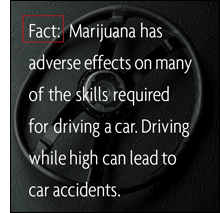 |


 Q: What happens after a person smokes marijuana? Q: What happens after a person smokes marijuana?
A: Within a few minutes of inhaling marijuana smoke, the user will likely feel, along with intoxication, a dry mouth, rapid heartbeat, some loss of coordination and balance, and a slower than normal reaction time. Blood vessels in the eye expand, so the user’s eyes look red.
For some people, marijuana raises blood pressure slightly and can double the normal heart rate. This effect can be greater when other drugs are mixed with marijuana, but users do not always know when that happens.
As the immediate effects fade, usually after 2 to 3 hours, the user may become sleepy.
Q: How long does marijuana stay in the user's body?
A: THC in marijuana is readily absorbed by fatty tissues in various organs. Generally, traces (metabolites) of THC can be detected by standard urine testing methods several days after a smoking session. In heavy, chronic users, however, traces can sometimes be detected for weeks after they have stopped using marijuana.
Q: Can a user have a bad reaction?
A: Yes. Some users, especially those who are new to the drug or in a strange setting, may suffer acute anxiety and have paranoid thoughts. This is more likely to happen with high doses of THC. These scary feelings will fade as the drug’s effects wear off.
In rare cases, a user who has taken a very high dose of the drug can have severe psychotic symptoms and need emergency medical treatment.
Other kinds of bad reactions can occur when marijuana is mixed with other drugs, such as PCP or cocaine.
 Q: How is marijuana harmful? Q: How is marijuana harmful?
A: Marijuana can be harmful in a number of ways, through immediate effects and through damage to health over time.
Marijuana hinders the user’s short-term memory (memory for recent events), and he or she may have trouble handling complex tasks. With the use of more potent varieties of marijuana, even simple tasks can be difficult.
Because of the drug’s effects on perceptions and reaction time, users could be involved in auto crashes. Drug users also may become involved in risky sexual behaviors, which could lead to the spread of HIV, the virus that causes AIDS.
Under the influence of marijuana, students may find it hard to study and learn. Young athletes could find their performance is off; timing, movements, and coordination are all affected by THC.
Some of the more long-range effects of marijuana use are described later in this document.
Q: How does marijuana affect driving?
A: Marijuana affects many skills required for safe driving: alertness, concentration, coordination, and reaction time. Marijuana use can make it difficult to judge distances and react to signals and sounds on the road.
There are data showing that marijuana can play a role in motor vehicle crashes. Studies show that approximately 4–14 percent of drivers who sustained injury or died in traffic accidents tested positive for THC. In many of these cases, alcohol was detected as well. When users combine marijuana with alcohol, as they often do, the hazards of driving can be more severe than with either drug alone. In a study conducted by the National Highway Traffic Safety Administration, a moderate dose of marijuana alone was shown to impair driving performance; however, the effects of even a low dose of marijuana combined with alcohol were markedly greater than those of either drug alone.
In one study conducted in Memphis, Tennessee, researchers found that, of 150 reckless drivers who were tested for drugs at the arrest scene, 33 percent tested positive for marijuana, and 12 percent tested positive for both marijuana and cocaine. Data also show that while smoking marijuana, people display the same lack of coordination on standard “drunk driver” tests as do people who have had too much to drink.
|
| <<
Previous Page |
Index |
Next Page >> |
|
 |

Marijuana: Facts for Teens (Revised)
La marihuana - Información para los adolescentes (Versión
Revisada)
Marijuana: Facts Parents Need to Know (Revised)
La marihuana: Lo que los padres deben saber (Versión
Revisada)
These publications may be reprinted without permission.
|
|